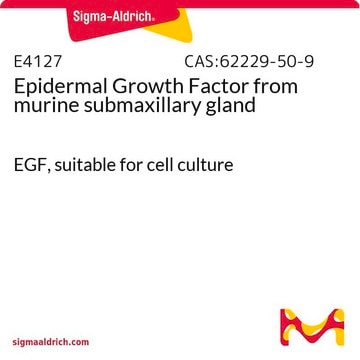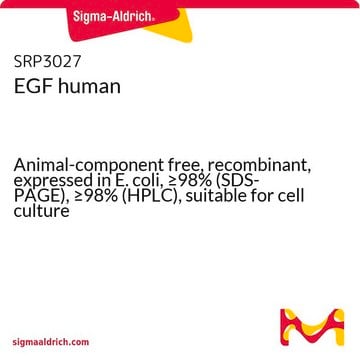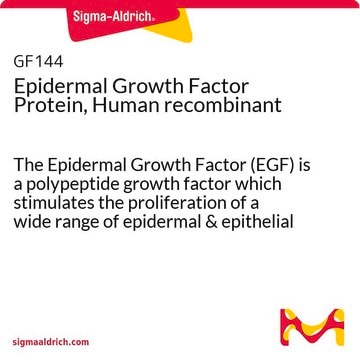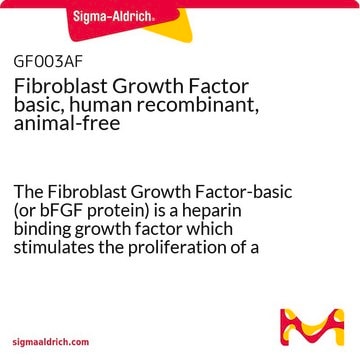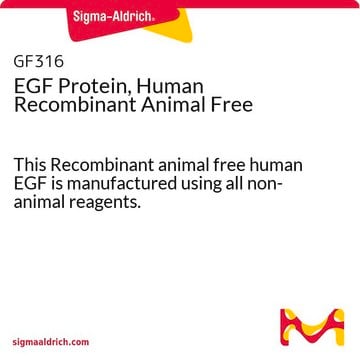E9644
hEGF
EGF, recombinant, expressed in E. coli, lyophilized powder, suitable for cell culture
Synonym(s):
Epidermal Growth Factor human, EGF
About This Item
Recommended Products
biological source
human
Quality Level
recombinant
expressed in E. coli
Assay
≥97% (SDS-PAGE)
form
lyophilized powder
potency
0.08-0.8 ng/mL ED50/EC50
mol wt
~6 kDa
packaging
pkg of 5X0.2 mg
pkg of 0.2 mg
pkg of 0.5 mg
storage condition
avoid repeated freeze/thaw cycles
technique(s)
cell culture | mammalian: suitable
impurities
≤1 EU/μg endotoxin (EGF)
color
white
solubility
water: soluble, clear, colorless
UniProt accession no.
storage temp.
−20°C
Gene Information
human ... EGF(1950)
Looking for similar products? Visit Product Comparison Guide
Application
Biochem/physiol Actions
Cellular functions affected by EGF: mitosis, ion flux, glucose transport, glycolysis, nucleic acid and protein synthesis, survival, growth, proliferation and differentiation.
Biological affects of EGF: inhibition of gastric acid secretion, fetal growth and development and neuromodulation in the central nervous system.
Pathways affected by EGF: EGFR signaling, MAPK cascade, PIP, Ca+2 signaling
Components
Caution
Preparation Note
Analysis Note
Storage Class Code
11 - Combustible Solids
WGK
WGK 3
Flash Point(F)
Not applicable
Flash Point(C)
Not applicable
Personal Protective Equipment
Certificates of Analysis (COA)
Search for Certificates of Analysis (COA) by entering the products Lot/Batch Number. Lot and Batch Numbers can be found on a product’s label following the words ‘Lot’ or ‘Batch’.
Already Own This Product?
Find documentation for the products that you have recently purchased in the Document Library.
Customers Also Viewed
Articles
Human pancreatic cancer organoid biobank (PDAC organoids) with various KRAS mutations to aide in 3D cell culture and cancer research applications.
Human pancreatic cancer organoid biobank (PDAC organoids) with various KRAS mutations to aide in 3D cell culture and cancer research applications.
Human pancreatic cancer organoid biobank (PDAC organoids) with various KRAS mutations to aide in 3D cell culture and cancer research applications.
Human pancreatic cancer organoid biobank (PDAC organoids) with various KRAS mutations to aide in 3D cell culture and cancer research applications.
Protocols
A stem cell culture protocol to generate 3D NSC models of Alzheimer’s disease using ReNcell human neural stem cell lines.
A stem cell culture protocol to generate 3D NSC models of Alzheimer’s disease using ReNcell human neural stem cell lines.
A stem cell culture protocol to generate 3D NSC models of Alzheimer’s disease using ReNcell human neural stem cell lines.
A stem cell culture protocol to generate 3D NSC models of Alzheimer’s disease using ReNcell human neural stem cell lines.
Related Content
Monitor barrier formation using colon PDOs, iPSC-derived colon organoids, Millicell® cell culture inserts, and the Millicell® ERS. 3.0.
Monitor barrier formation using colon PDOs, iPSC-derived colon organoids, Millicell® cell culture inserts, and the Millicell® ERS. 3.0.
Our team of scientists has experience in all areas of research including Life Science, Material Science, Chemical Synthesis, Chromatography, Analytical and many others.
Contact Technical Service
